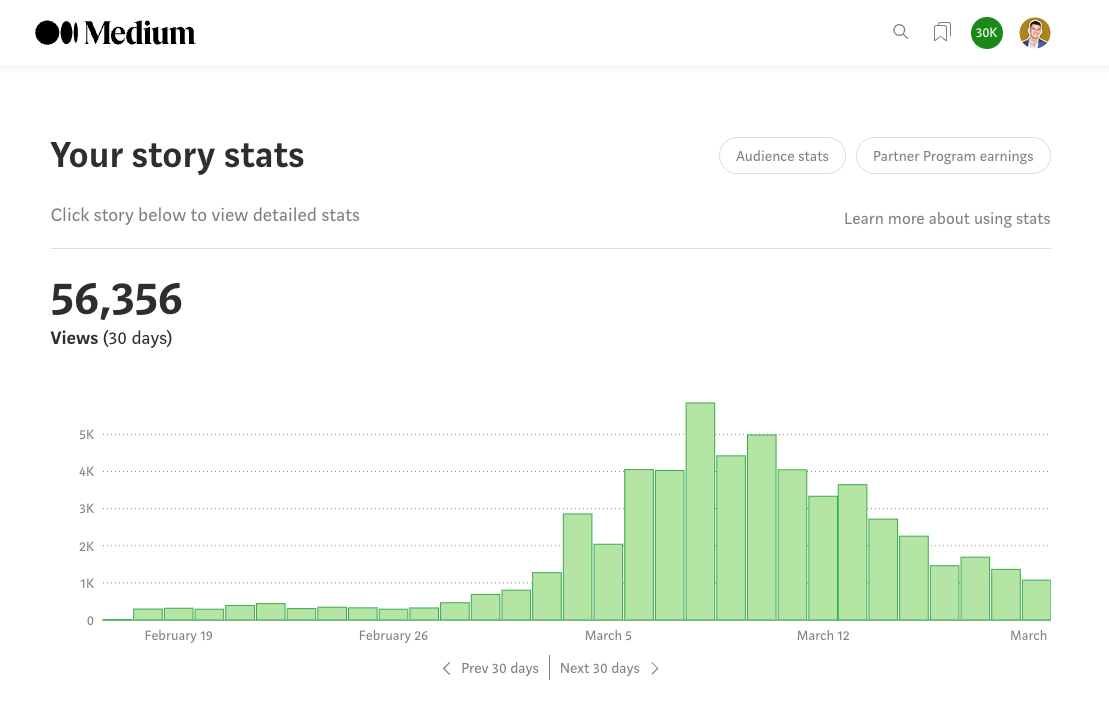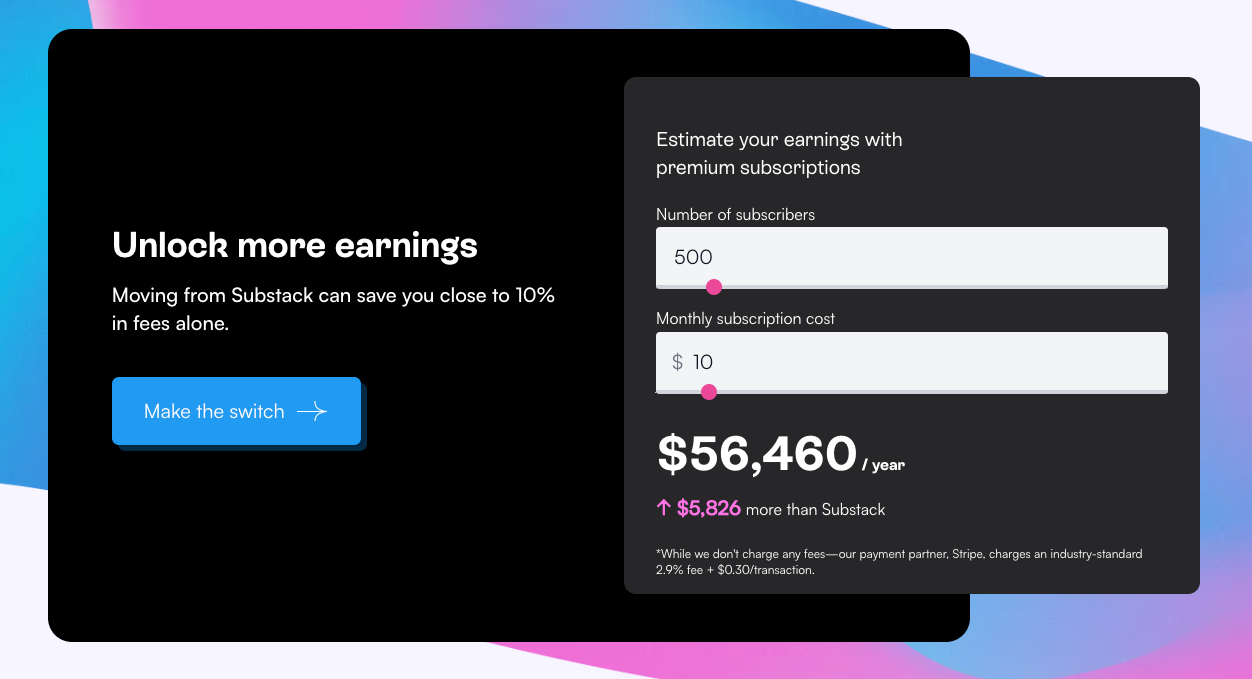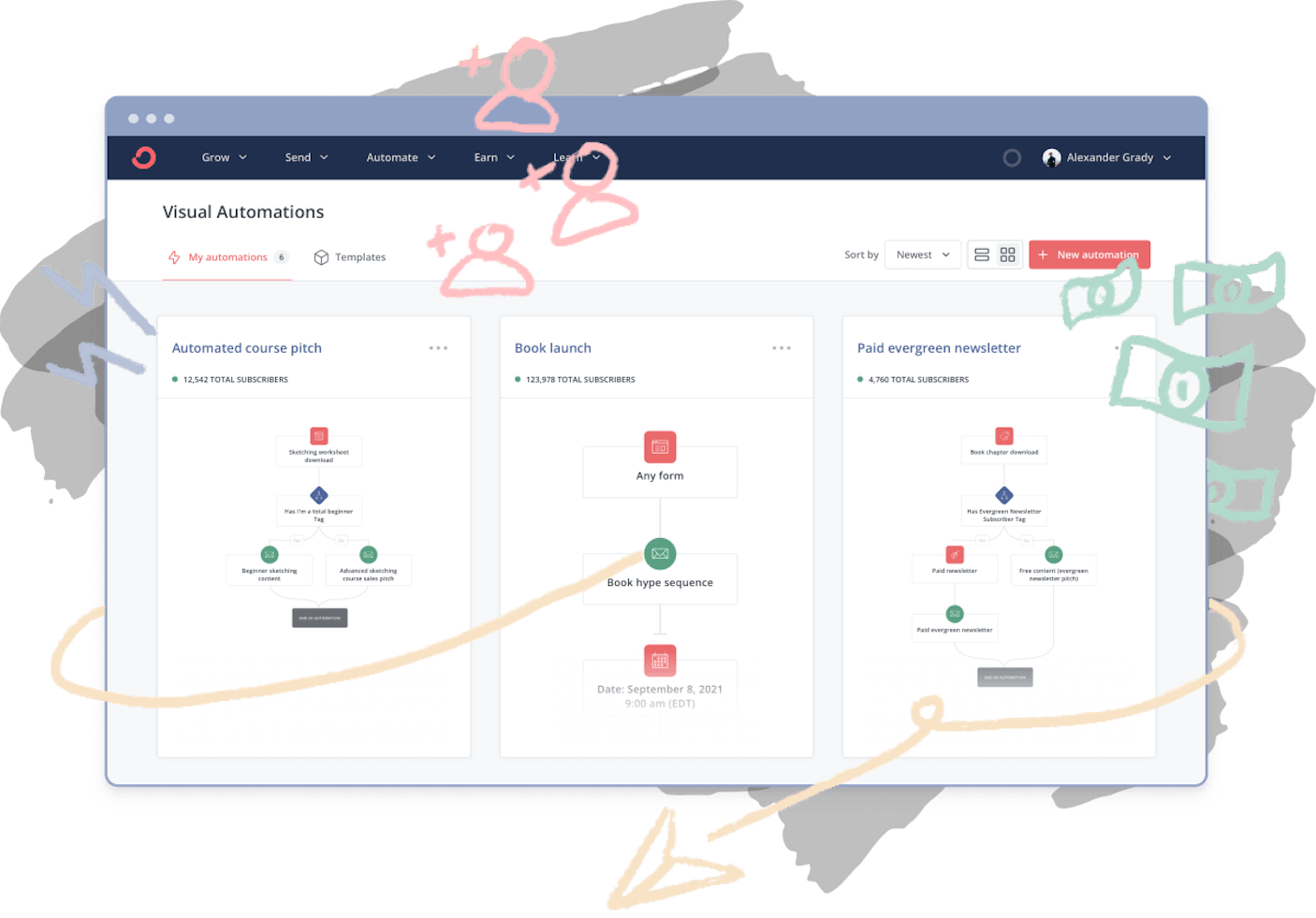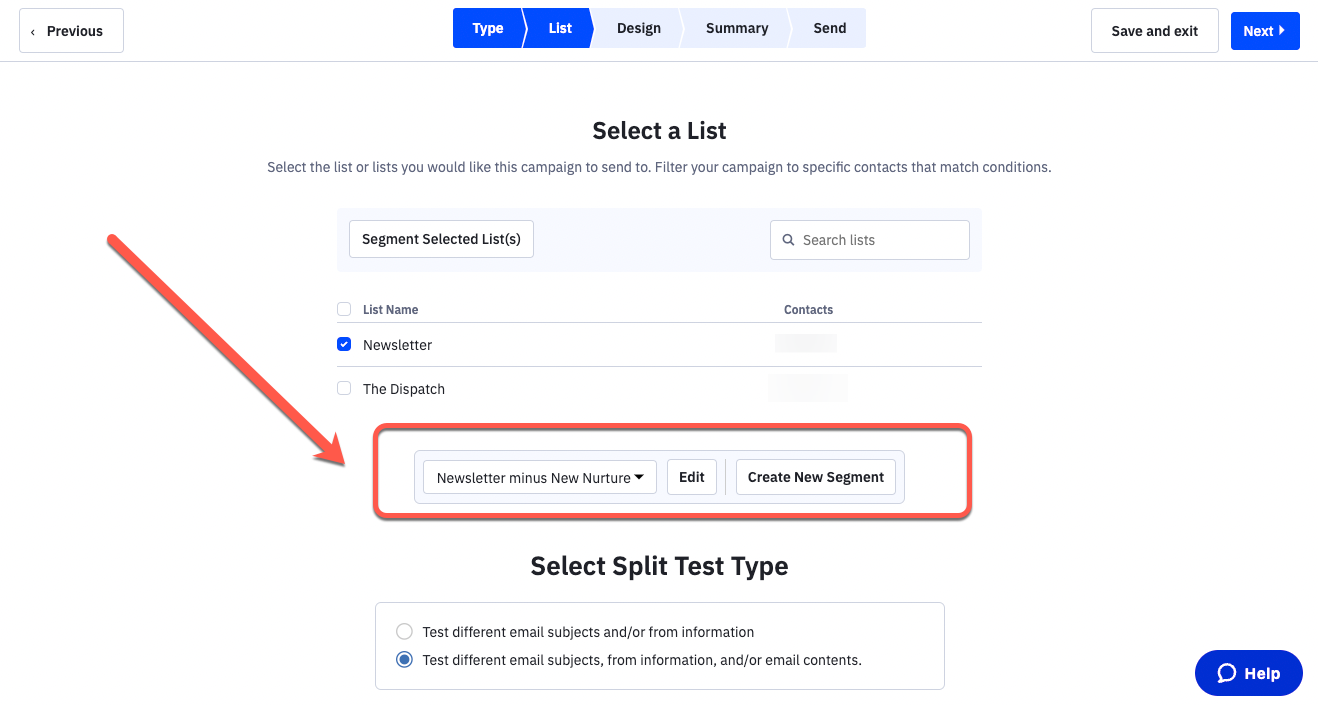(Disclosure: My blog is user-supported, and I only recommend offers and products I consume myself. This post contains affiliate links, for which I may earn a commission, at no additional cost to you. Read my full privacy policy here and editorial disclosures here.)
-
Substack is a popular writing and blogging platform. Is it right for you?
That ultimately depends on what you want to accomplish online. Substack is popular for its ability to offer paid subscriptions and a referral program. But other email marketing software options have more business tools.
Knowing the lay of the land can help independent writers make the decision that’s right for them.
Key Takeaways
- Substack allows users to create their own newsletter or even host entire media publications on one platform.
- There are community building features, and the Substack model is a free plan by default. The company makes its money on transaction fees from paying subscribers when they sign up for different subscription tiers.
- Paid newsletters are a tough sell, though. You might be better off building your own website or own brand outside of Substack’s platform.
- No matter where you decide to host your email marketing, remember that email is a separate strategy from getting traffic and views.
Let’s look at the best Substack alternatives to consider, based on your goals.
Table of Contents
Why Publish Content Online at All?
Online creators have flooded the internet in recent years. Creators are content professionals and amateurs who treat their channels as tiny little media publications. They create content that informs and/or inspires their audiences, and they can monetize this audience in a number of ways:
- Brand deals.
- Display ads.
- Affiliate link commissions.
- Selling to readers directly.
Business owners have taken a page out of the creator playbook. By producing and publishing quality content, they’re able to build an online community and sign multiple users up for marketing emails, which can help feed sales funnels.
Businesses love to use email because email lets them advertise for free, especially in ecommerce. There’s a reason you’re prompted to sign up for emails in exchange for a discount when you shop online: Email works.
Substack’s Advantage
For email marketing to work, you need a way for non-email subscribers to see your content in the first place. Otherwise they’ll never sign up!
This usually results in two content marketing strategies: One for views, to attract new subscribers, and another to engage existing subscribers.
Substack lets you combine both of these efforts into one platform. But the discoverability of your content isn’t great from an SEO perspective. And although the newsletter feature has a minimalist interface, other tools have much better features.
Takeaway:Content helps inform and inspire readers. Consumers increasingly shun paid advertisements in favor of informative posts, images, videos, or feeds.
Email Service Providers Are Business Tools—Even If You Don’t Want Paid Subscriptions or a Membership Platform
Substack is missing many of the more advanced features that other software tools can provide. An email service provider, or ESP, will have automation features, detailed analytics, and an ability to send more personalized emails.
Additionally, paid subscriptions are a tough sell these days. Unless you’re a leading journalist or influencer, or are covering a very niche topic with rigor and detail, a premium subscription can be a tough sell compared to other monetization strategies.
Remember that Substack jump started their business by offering large advances to established writers who already had huge followings or a massive Twitter profile.

Substack has a guide on its website for how to launch your paid newsletter tier. The Tl;DR is that they suggest you need a well-established list of non-paying subscribers first. (Screenshot taken August 16, 2023)
6 Substack Alternatives to Consider *Specifically* for Publishing
If your primary goal is to reach more readers on the internet with your writing, here are six platforms to know about that could make your written content more discoverable.
No. 1: Medium
Medium is an open-source publishing platform. You can publish and save articles, and also have the option to put articles behind a paywall through the Medium Partner Program.
Medium is my battle ax of choice, and with the partner program, I’ve made anywhere from $100—$7,000 in a month in royalties, on top of bringing email subscribers over to my list.


Medium has clear audience and traffic dashboards for article performance
If you don’t want to deal with web hosting or website builders, you can leverage Medium to share your perspectives with others. You can also create your own publications within Medium, but that’s totally optional.

I started on Medium in 2020, but didn’t create a publication until 2023.
Medium is not a newsletter platform, so while it is one the best viable alternatives to Substack, you’ll still need a separate email marketing service.
🔗 Related: The Ultimate Guide to Writing on Medium
No. 2: Ghost
When media websites like The Atlantic are using your publishing platform, you know you’re doing something right.
Ghost is a subscription service that appeals to creators, journalists, independent writers, and small businesses. Ghost has become a popular alternative to Substack because it works as both a blogging platform and standalone newsletter subscriptions.

Ghost’s analytics interface is more robust than what you get with Substack.
Ghost has a generous free plan. If you choose a paid plan, you’ll pay a flat fee each month, similar to an email service software. You’ll then be able to use the subscription widget to charge whatever rates you want. Ghost lets you run multiple newsletters from the same account, and the creator feedback has been really strong.
If you want to create a media publication, Ghost is a great platform with plenty of custom themes to choose from.

Ghost has a beautiful publishing interface, but you’ll still need to solve for traffic and driving views to your posts.
No. 3: Beehiiv
Beehiiv is a newsletter tool built by the team that launched Morning Brew. You may not have heard of this software before, but they have several unique features that might tip you over the edge.
Similar to Substack and Ghost, Beehiiv is an all-in-one newsletter platform that includes landing pages and space to offer paid plans. But one especially interesting feature it offers is the ability to bring in ads from a dedicated sponsorship network.
Ever see newsletters with sponsor logos at the top? You could have that on your newsletter if you wanted. Simply apply to Beehiiv’s ad network as a Beehiiv user, get approved, and then start monetizing your newsletter, without needing paying subscribers.

Beehiiv chose violence today. A calculator on their homepage lets you see how much more money your paid newsletter would make with them than with Substack.
Another big advantage to Beehiiv is that it has an open API. If you use other software tools, and want to connect them to Beehiiv using a tool like Zapier or custom code, you can do that. Unlike Substack, Beehiiv has integration options.
The paid subscribers model is a tough sell, so the fact that this newsletter has a built-in ad model feature makes it one of the most viable alternatives to Substack in my opinion.
No. 4: Tinyletter
Tinyletter was acquired by Mailchimp in 2011. I don’t recommend Mailchimp for ethical reasons described here, but it might be a good fit for you.
The platform had a value proposition that was trendy in the 2010s: Clean, simple email marketing. While it was the only platform to offer this smooth of an interface, Substack caught and passed Tinyletter long ago.
Tinyletter works as a Substack alternative, but only if you want absolute bare-bones features and nothing else.
Pro Tip:Don’t use Tinyletter.
No. 5: Threads
Threads is the new kid on the block, having debuted in summer of 2023. The Twitter-like social media feed is similar to Twitter, but with better-reinforced community guidelines.
Keep in mind that Threads is for short-form content. If you want to write blogs, articles, or newsletters, it may not work as a Substack alternative.
No. 6: Blogging
Ah, yes—blogging. It’s ancient and it’s boring. And yet it still works.
The pro of blogging is that you can completely customize your publishing approach to align with your goals. You have your own server, you have a custom domain, and you can connect whatever newsletter platform you want.
The con is that you have to know how to do that stuff, and most bloggers need multiple software tools in order to do so. I choose blogging because I rely on SEO to have my posts be more discoverable and have new readers find my blogs.
🔗 Related: Behind the Scenes of My Pro Consultant Website Rebuild
4 Substack Alternatives to Consider Specifically for Email
We’ve covered six alternatives to Substack for publishing content on the internet.
But perhaps you already have the publishing part figured out, and now you’re trying to find the right newsletter platform to match.
The following tools offer more features and don’t require coding knowledge, allowing creators to get more out of their email efforts. They also all offer automations, which are critical if you want to build sales campaigns or other content efforts that can run automatically.
No. 1: ConvertKit
ConvertKit is probably the best alternative to Substack, and the most similar. The free plan lets you have up to 1,000 subscribers, and their free plan includes landing pages and a checkout function.

Moreover, ConvertKit has a checkout feature that takes a very low percentage of the transaction. In addition to the 2.9% fee collected by payment provider Stripe, ConvertKit takes just 0.6% of the transaction. Substack, meanwhile, takes a whopping 10%.
Although you do have to start paying for ConvertKit after you reach 1,000 subscribers, their starter plan, the Creator plan, starts at just $29 per month. You can also create automated sequences and different types of lists.

ConvertKit seems to be one of the best Substack alternatives because its newsletter feature is similar to what Substackers are looking for.
🔗 Related: ConvertKit Review: Pros and Cons to Consider
No. 2: ActiveCampaign
If you want an email service provider that can do it all, ActiveCampaign is for you. While there is no free tier, the monthly fees are similar to what you would pay for ConvertKit.
ActiveCampaign shines in the automation and customization department. You can create conditional content in emails, tag and score contacts, and build automations based on reader behavior.

ActiveCampaign is a little more advanced. It does, however, have the best automation and conditional content features.
ActiveCampaign is what I personally use for my email efforts, and have been on it since late 2016.
🔗 Related: ActiveCampaign Review: A Robust Email Service Provider
No. 3: Flodesk
Flodesk is a woman-owned email service provider company that was founded in 2019. Flodesk emphasizes simplicity, and was launched as a response to other email service providers becoming heavy and complex.
Although Flodesk doesn’t have the same features as other providers, the price is hard to beat: Unlimited subscribers for $35 per month. They also have a checkout function, which is a separate cost, but you can bundle them together for $58 per month.
If you have a large list, an email service provider can get expensive, because most ESPs tier their pricing by subscriber count. For example, a list of 25,000 subscribers on ConvertKit would cost $166 per month to maintain. A list of 50,000 would cost $266 per month.
Flodesk is one price, no matter your list size.
No. 4: MailerLite
If you love the idea of an email service provider, but want to keep things simple, MailerLite is another great option.
Mailerlite works well as a Substack alternative. Its main difference from tools like ConvertKit and ActiveCampaign is that automations are available on the free tier of MailerLite’s platform.
If you are getting started with email and just want to tinker with automations for free, MailerLite takes the cake.
Frequently Asked Questions
Is There a Free Substack?
Substack is already free. Instead of a flat fee, Substack takes a 10% cut of any paid plans you sell to your subscribers.
What Are the Disadvantages of Substack?
Substack doesn’t offer automations, and doesn’t hold much contact data. If you want to collect subscriber information such as name or zip code, you won’t be able to do that on Substack.
Which Is Better, Substack or Medium?
Each platform has its pros and cons. Medium is better for discoverability. Substack is more sleek and has an ecosystem of independent writers, but growth can be tough.
Which Is Better, Substack or Tinyletter?
Substack has more features than Tinyletter, along with a built-in community. Tinyletter was acquired by Mailchimp in 2011.
Which Is Better, Substack or Ghost?
Although Ghost doesn’t have as many users, it has superior features. You can craft more of a destination on Ghost than Substack.
Which Is Better, Substack or Beehiiv?
Beehiiv has more impressive features than Substack, and it has an open API, so you can integrate it with other software tools. There is also a display ad network you can tap into to monetize your newsletter.
What Is the Downside of Substack?
Substack doesn’t offer automations, and it’s not very flexible. You’ll have to constantly keep creating content to keep up.
Can You Read Someone’s Substack Without Paying?
Don’t be a grifter—support independent writers. Besides, the creator is the one who controls who can and can’t read their paid content, so it varies from newsletter to newsletter.
How Much Does Substack Cost?
Substack is free to use. When you offer paid subscriptions through the platform, Substack takes a 10% cut.
What Is the Minimum Subscription Fee for Substack?
If you sell subscriptions on Substack, the minimum you will need to charge is $5 per month.
The Takeaway
Substack has a lot of optics and media buzz. But there’s actually an entire industry for aspiring newsletter writers, with many options to choose from.
Take the time to do some digging and you’ll soon find the perfect platform for your online goals. ◆
Thanks For Reading 🙏🏼
Keep up the momentum with one or more of these next steps:
📣 Share this post with your network or a friend. Sharing helps spread the word, and posts are formatted to be both easy to read and easy to curate – you'll look savvy and informed.
📲 Hang out with me on another platform. I'm active on Medium, Instagram, and LinkedIn – if you're on any of those, say hello.
📬 Sign up for my free email list. This is where my best, most exclusive and most valuable content gets published. Use any of the signup boxes on the site.
🏕 Up your writing game. Camp Wordsmith® is a content marketing strategy program for small business owners, service providers, and online professionals. Learn more here.
📊 Hire me for consulting. I provide 1-on-1 consultations through my company, Hefty Media Group. We're a certified diversity supplier with the National Gay & Lesbian Chamber of Commerce. Learn more here.


